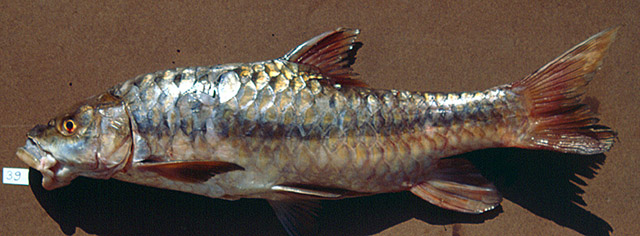| Cyprinidae (Minnows or carps), subfamily: Torinae |
| 60 cm SL (male/unsexed) |
|
benthopelagic; freshwater |
| Asia: Mekong basin in Laos and Yunnan, China. |
|
Dorsal spines (total): 4-4; Dorsal soft rays (total): 8-8; Anal spines: 3-3; Anal soft rays: 5-5. Elongated median lobe on the lower lip reaching beyond an imaginary line between the corners of the mouth (in specimens > about 7 cm SL); the upper lip rolled upwards and backwards but without median lobe; a dark brown longitudinal stripe along middle side in adults; fins red in adults and paler in juveniles, usually 3+1/2 scale rows between the lateral line and the dorsal- fin origin (Ref. 27732). Having fewer lateral line scales (25) and predorsal scales (9); eye diameter small (14.6-19.7% of HL); eyes not visible in ventral view; supero-posterior margin of dorsal deeply concave; isthmus with visible, small scales; gill rakers 19-22 (Ref. 13848). |
| Large adults are found in deep pools; juveniles were most frequently found in shallow areas with sandy substrate (Ref. 27732). Its meat becomes poisonous to eat after feeding on the fruits of certain trees (Ref. 43281). Reaches up to at least 60 cm SL (Ref. 27732). |
|
Data deficient (DD); Date assessed: 05 August 2018 Ref. (130435)
|
| harmless |
Source and more info: www.fishbase.org. For personal, classroom, and other internal use only. Not for publication.
